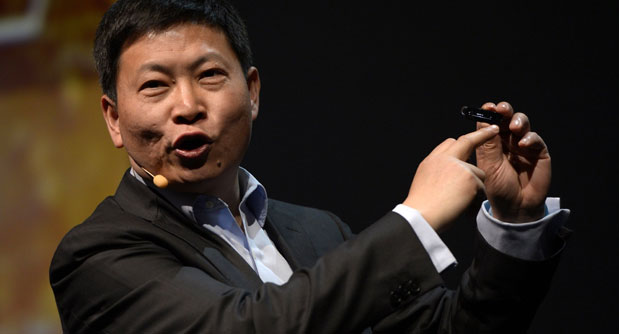
CEO Huawei Consumer Business Group, Richard Yu, presents the Talkband B1 at the 2014 Mobile World Congress in Barcelona on February 23, 2014. AFP
BARCELONA – Rising Chinese smartphone maker Huawei launched Sunday a connected watch to rival Samsung’s Gear 2, both unveiled on the eve of the world’s biggest mobile fair in Barcelona, Spain.
Huawei, already a major force in building mobile networks and the world number three smartphone maker in 2013, showed off its TalkBand, to be sold for 99 euros ($136).
Connected by Bluetooth to a smartphone, the watch lets you receive calls and messages without removing your mobile from your pocket, as well as measuring the steps you take with a podometer and even following your sleep pattern.
“When you look around us, everything is getting connected”, Huawei consumer business unit vice president Colin Giles said.
“We will launch its first in China, then in the rest of the world,” he told AFP ahead of the February 24-27 World Mobile Conference.
To take a call, the user lifts the face off the watch and puts it to his or her ear, like a hands-free kit, he said.
It works only with Huawei smartphones for the moment but is to be made compatible with other brands later.
Just a few hours earlier, Samsung launched the Gear 2, after a first version won over few critics, adding new features and ditching Google’s Android in favour of its own operating system.
The South Korean electronics giant revealed the new watch in a statement before unveiling on Monday its new flagship smartphone, almost certainly the Galaxy S5.
Besides an array of features including sports tracking software and a heart rate monitor, the Gear 2 marks an important and widely anticipated step towards independence from Android.
The watch, available in two models – the Gear 2 and the Gear 2 Neo, which has no camera – will be powered by the Tizen operating system developed by Samsung with various partners to break free of the Android dominance.
The first Gear, launched last September, was criticised by many for being unfashionable and unwieldy.
– Mature markets slowing –
Samsung, like other device makers, is banking on smart devices to boost revenue as sales of smartphones slow in the mature markets, which are also the most profitable.
Though smartphone sales surged 42 percent to 968 million units last year, according to Gartner, the growth came from developing markets such as Latin America, India and China while mature markets such as western Europe and the United States hit the brakes.
“We will see all of the handset companies responding to slowing growth in the smartphone market and the difficulty of making money,” said Ian Fogg, senior principal analyst of electronics and media at research house IHS.
“They are going to launch a number of smart accessory devices including wearable devices that will give them opportunities in new markets to generate revenues and growth.”
Research house Canalys predicts world sales of 17 million smart bracelets and watches this year, rising to nearly 45 million in 2017.
Besides the new watch, Huawei launched a new wifi hotspot device, a smartphone designed for ultra-fast 4G networks and a mini tablet that can also be used as a smartphone.
China’s smartphone makers are on a global expansion drive that could eventually challenge market leaders Samsung and Apple, analysts say.
Chinese manufacturer Lenovo struck a dramatic blow in its campaign in January, agreeing the $2.9 billion purchase of the loss-making Motorola Mobility from Google to grab a strong platform in the Americas and a foothold in Europe.
Smaller Chinese manufacturers are showing off bigger ambitions, too, with upstart Xiaomi, for example, hiring a Google executive, Hugo Barra, in August 2013. It launched a new, low-priced smartphone brand, Redmi, this month.